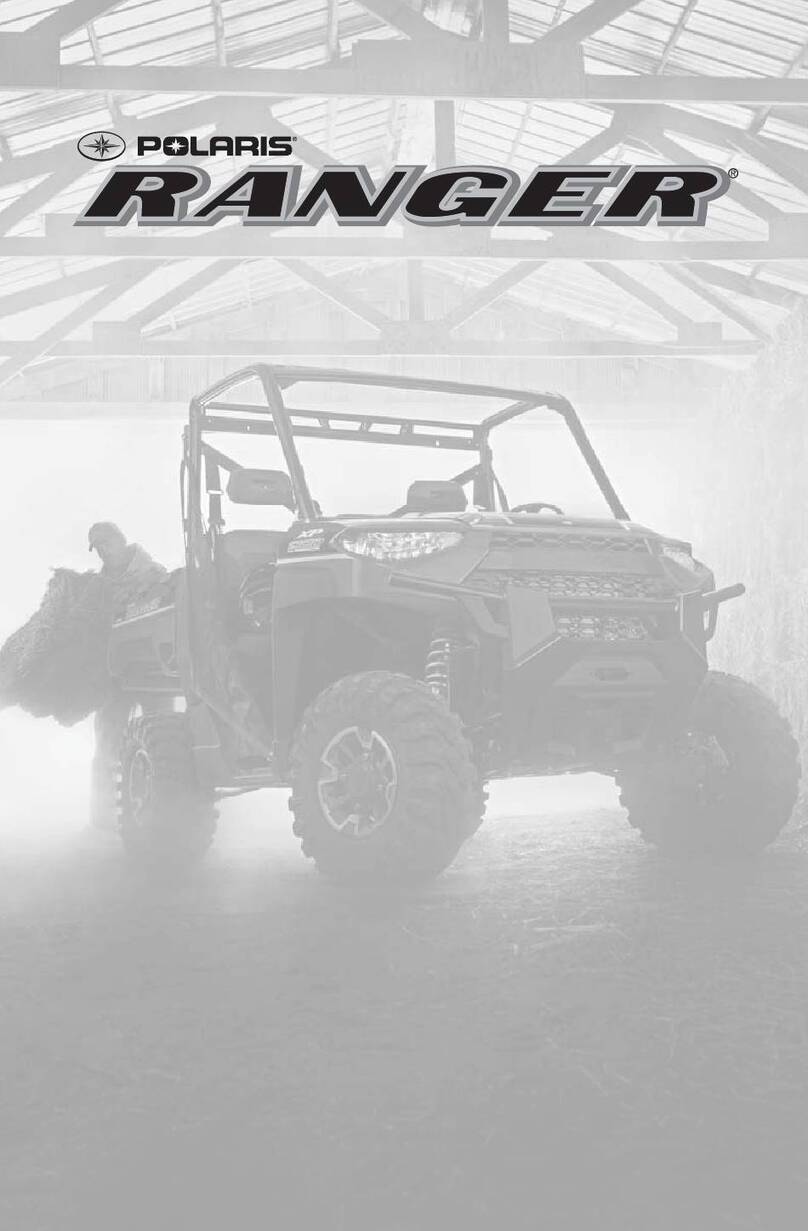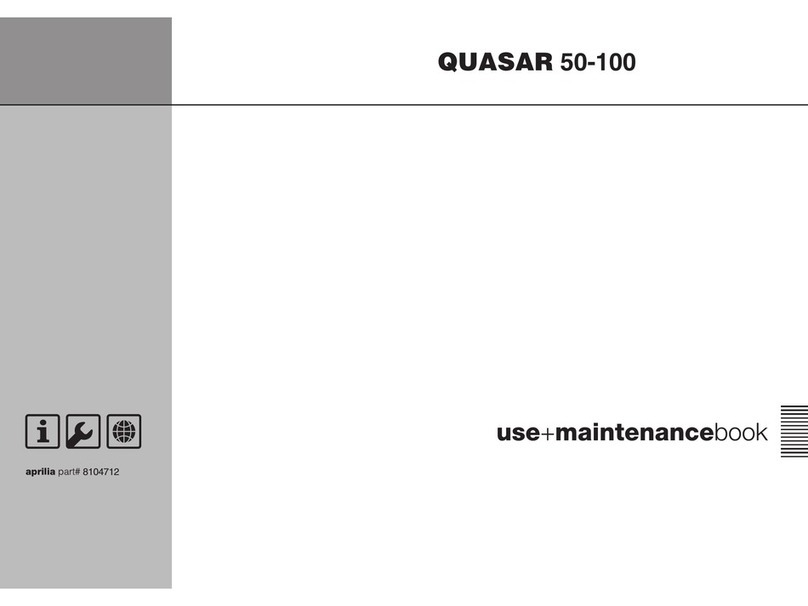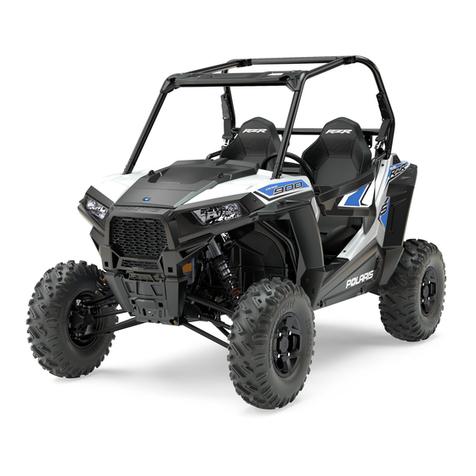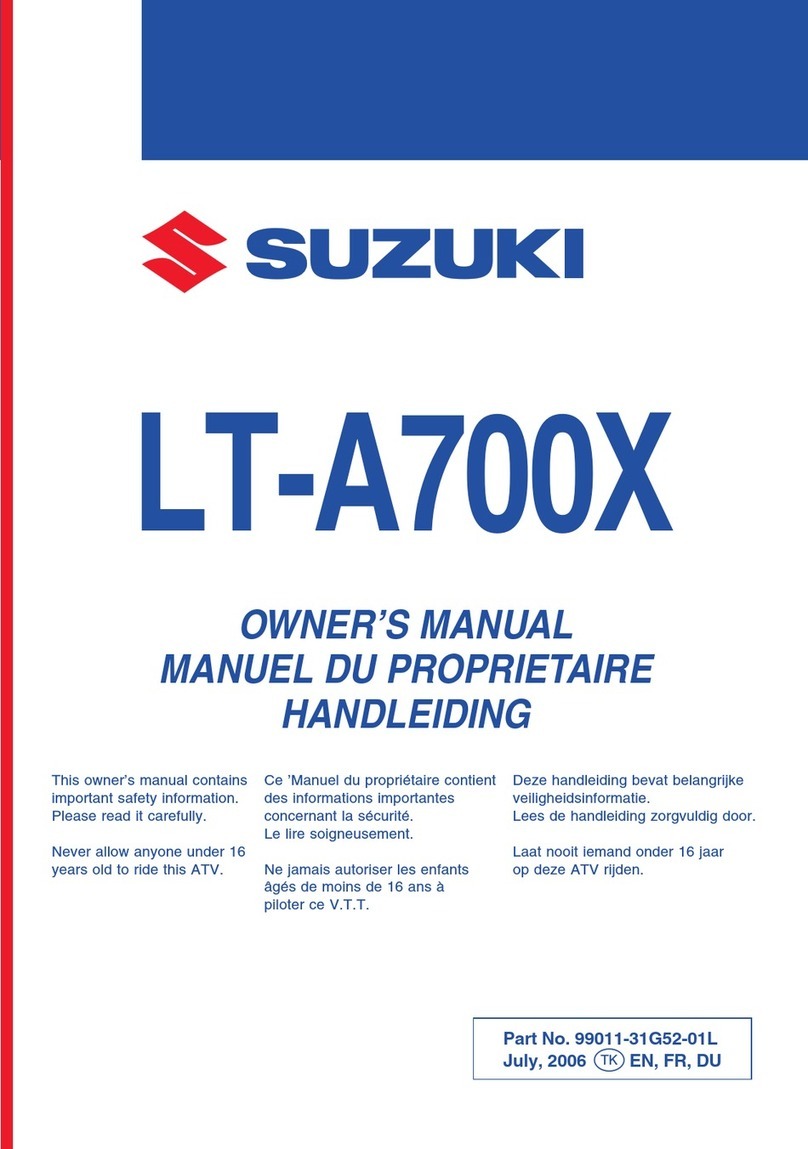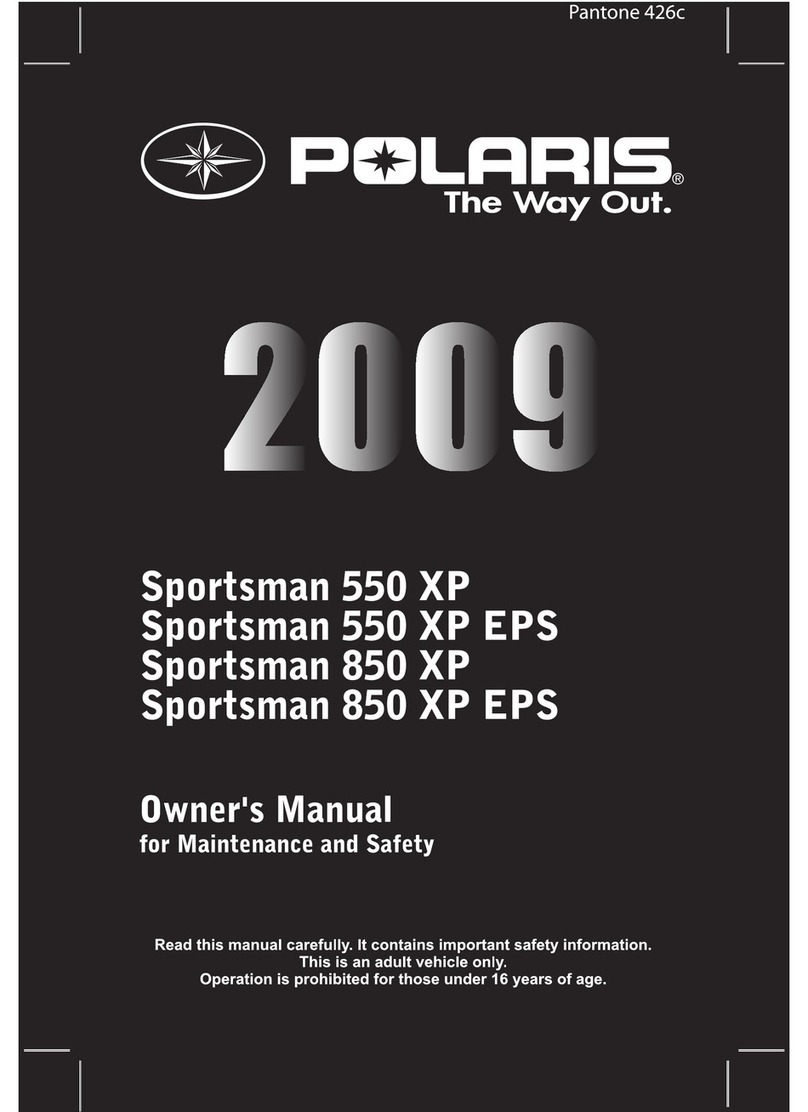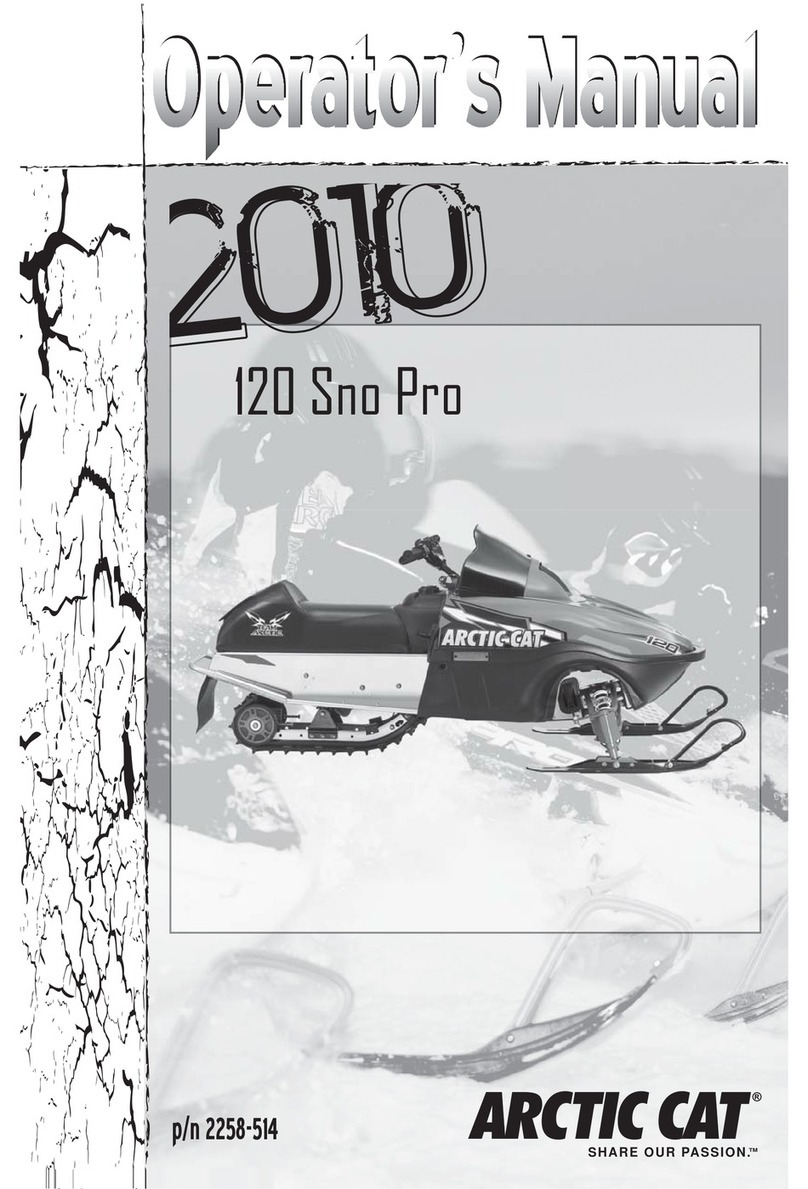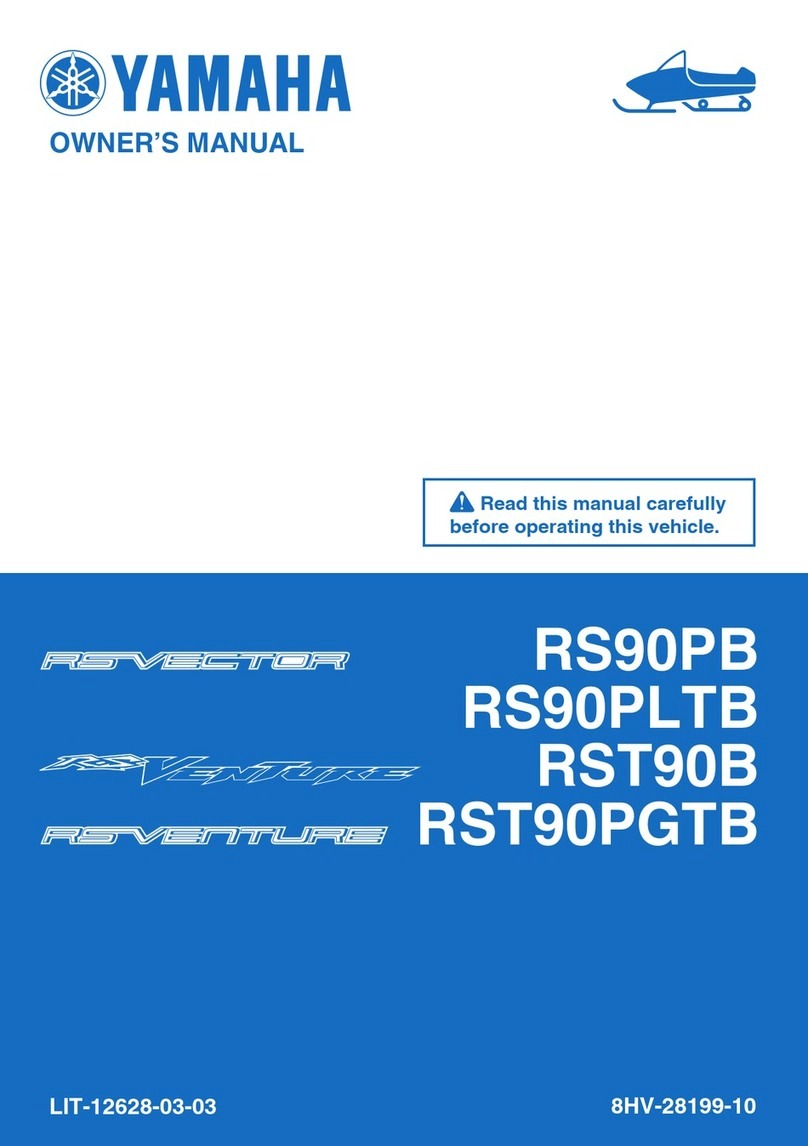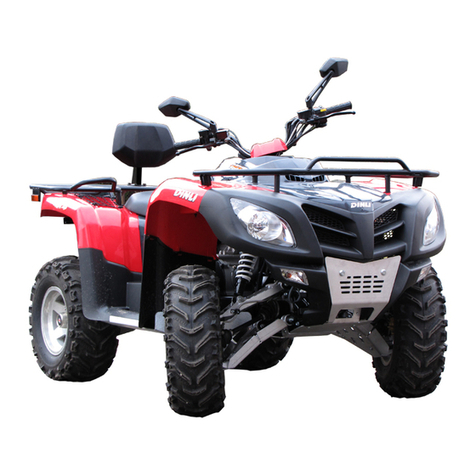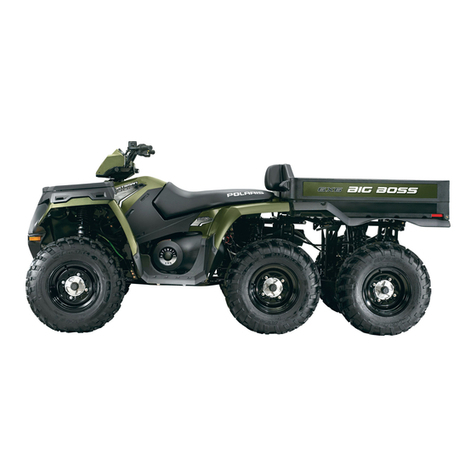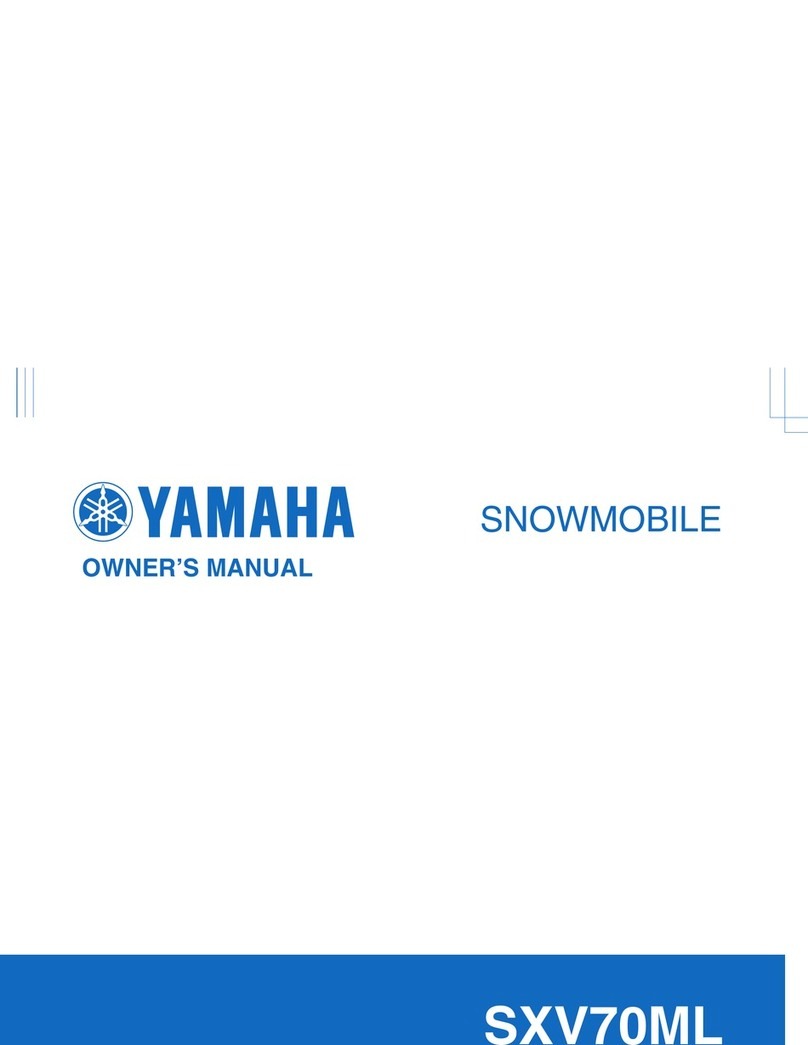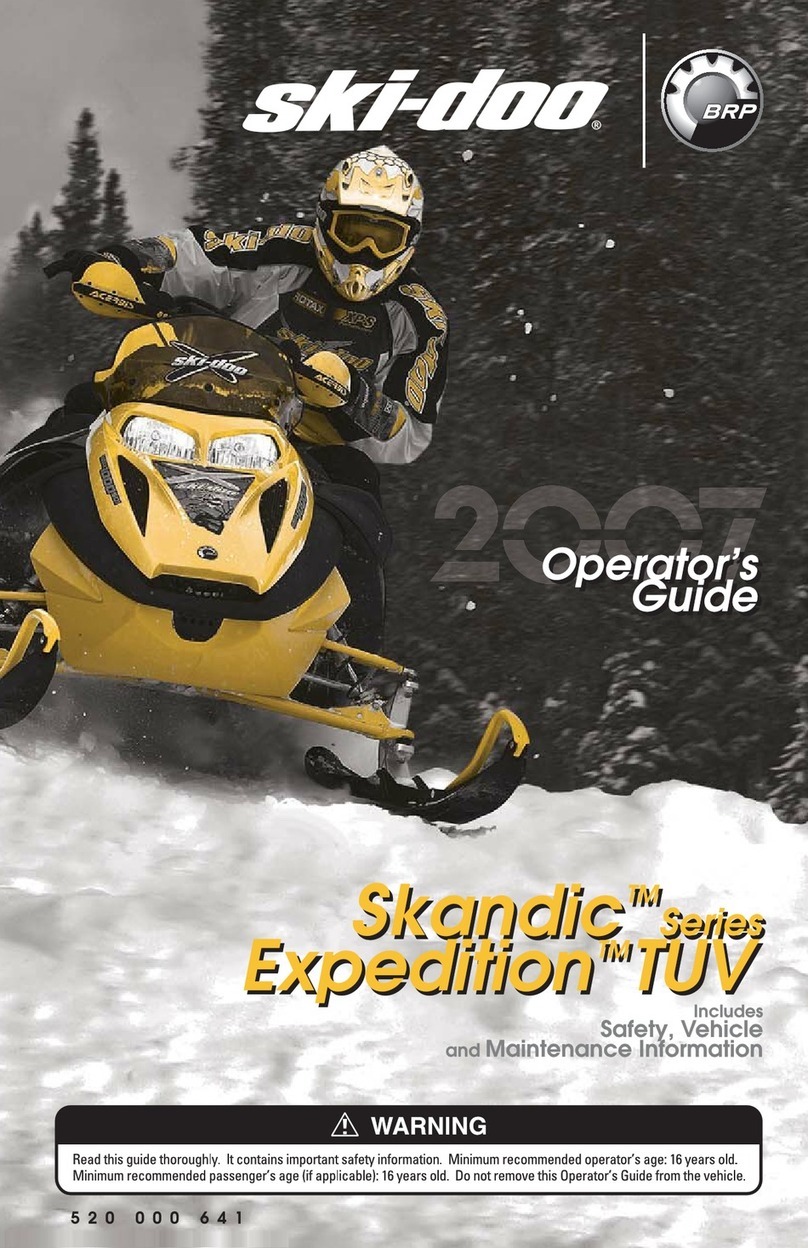Thumpstar SXS300 Owner's manual

OWNER’S/OPERATOR’S
MANUAL
SXS300
Designed and manufactured
for OFF-ROAD use only!
For age of 16 and up
only to operate!
This operation manual is made for UTV models:
CHEETAH 150 | CHEETAH 150X | CHEETAH 200 | CHEETAH 200X
CHEETAH 200-E | CHEETAH 200E-X | CHEETAH 300-E
CHEETAH 300E-X | CHEETAH 300 | CHEETAH 300X
Provincial/Municipal governments have different regulations pertaining to owning and
operating an off-road vehicle, learn the regulations in your area.
READ THIS MANUAL CAREFULLY!

Welcome Introduction
Thank you for purchasing our Products. We hope
you will enjoy it. Before you start to operate the
vehicle, please read through this owner’s manual
carefully as it contains important safety and
maintenance information. Failure to follow the
warnings contained in this manual can result in
serious injuries in juries or death.
Be sure to follow the recommended maintenance
schedule and service your vehicle accordingly.
Preventive maintenance is extremely important to
the longevity of your vehicle. We hope you will have
a pleasant experience with our product and thank
you again for choosing our Products.
For questions regarding operation and maintenance
of this vehicle, please contact the authorized dealer.
Content
WELCOME INTRODUCTION 01
BUYERS SAFETY AGREEMENT 02
IMPORTANT MANUAL INFORMATION 04
LOCATION OF WARNING STICKERS 05
SAFETY INFORMATION 07
DESCRIPTION AND VEHICLE IDENTIFICATION 09
CONTROL FUNCTIONS 12
PRE-OPERATING CHECKS 17
OPERATION 21
DRIVING YOUR VEHICLE 24
PERIODIC MAINTENANCE AND ADJUSTMENT 26
Troubleshooting 35
Cleaning and Storage 36
Specifications 38
Spare Part Catalogue 40
01

03
Buyers Safety Agreement (2/2)
Always be careful when skidding or sliding. On extremely slippery surfaces such
as ice, go slow and be very cautious in order to reduce the chance of skidding
or sliding out of control.
Never do wheelies, jumps or any stunts.
Never operate the vehicle in fast flowing water. Remember that wet brakes
may reduce your stopping ability. Test your brakes after leaving the water. If
necessary, apply those several times to let friction dry out the linings.
Always use the size and type of tires specified in this manual. Always
maintain proper tire pressure as described in this manual.
All modifications to this vehicle should be made by a qualified mechanic.
Modification to the vehicle, including the use of performance parts or non-
original parts, will void the warranty in its entirety, unless express written
approval stating that the warranty will not be voided is obtained from
authorized dealer.
When transporting the machine in another vehicle, be sure that it is kept
upright and that the fuel cock is in the “off” position. Otherwise, fuel may
leak out of the carburetor or the fuel tank.
Always follow the break-in-period as described in the owner’s manual. Not
following the break-in period will void the engine warranty.
Always clean the air filter as described in the owner’s manual. Improper
maintenance of the air filter will void the engine warranty.
Failure to follow all warnings and unsupervised or irresponsible operation can
cause serious injury or death. By initialing each item on the above checklist, I
have indicated my complete understanding of these points, and I acknowledge
my responsibilities regarding the contents. I also agree to explain the points on
this checklist to anyone besides myself who will be operating the vehicle now
and/or in the future.
Dealer’s Signature Buyer’s Signature
Print Store Name Print Buyer’s Name
Date Date
VIN Number Model
Buyers Safety Agreement (1/2)
Always read the owner’s manual carefully before riding and follow the operating
procedures described in the owner’s manual.
Pay close attention to all warnings contained in the manual and on all labels.
This vehicle is designed for riders of 16 and older.
Both the parent and the child must fully understand everything in the owner’s
manual before riding.
Always wear a helmet, face shield, boots, gloves, and protective clothing
while riding.
Beginners should receive training from a certified instructor.
It is illegal to ride this vehicle on public roads or highways.
Do not allow your child to ride without supervision.
Do not ride under the influence of drugs or alcohol. They can affect your
judgment and slow your reaction time.
Always maintain a safe distance between your vehicle and vehicles around you.
Never ride this vehicle unless it has been properly adjusted and maintained.
Never run the engine in closed areas. The exhaust gas contains poisonous
carbon monoxide.
Do not touch any part of the engine, muffler, or the exhaust system during or
immediately after operation of the vehicle.
Always check for obstacles before operating in a new area.
It is highly recommended that this vehicle should not be driven at night or during
dark periods.
Never attempt to operate over large obstacles, such as large rocks, or fallen
trees. Always follow proper procedures when operating over obstacles as
described in this manual.
02

Important Manual Information
NOTE:
The operator, passenger, parents or guardian must read, study and understand
all the items contained within this owner/operator’s manual before operating this
vehicle. Failure to follow these instructions could endanger the personal safety of the
operator, passenger and any Bystanders.
FAILURE TO FOLLOW THE WARNINGS CONTAINED IN THIS MANUAL CAN
RESULT IN SERIOUS INJURY OR DEATH.
04 05
Location of Warning Stickers
Read and understand all of the labels on your vehicle. They contain important
information for safe and proper of your vehicle. Never remove any labels from
your vehicle. If a label becomes difficult to read or comes off, a replacement label is
available from your dealer.
The safety alert symbol means ATTENTION!
BECOME ALERT! YOUR SAFETY IS INVOLVED!
Failure to follow WARNING instructions could result in severe injury
or death to the vehicle operator, a bystander or a person inspecting
or repairing the vehicle.
A CAUTION indicates special precautions that must be taken to avoid
damage to the vehicle.
A NOTE provides key information to make procedures easier.
WARNING
CAUTION
NOTE

Location of Warning Stickers 06 07
Safety Information
This off-highway utility vehicle handles differently from other vehicles including cars
and ATVs. Where INJURY OR DEATH can result if you do not follow these instructions:
Read this manual and labels carefully and follow the operating procedures
described.
This vehicle is designed to carry the driver and one passenger. Never carry
passengers in the cargo bed.
Always be sure the driver and passenger are wearing seat belts.
Never give a ride to a passenger who is too small to reach and hold the
handgrip on the enclosure.
Always avoid operating the vehicle on any paved surfaces, including sidewalks,
driveways, parking Lots, and streets.
Never operate this vehicle in any public street, road, or highway, even dirt or
gravel one.
Never operate this vehicle without wearing an approved motorcycle helmet that
fits properly. You should also wear eye protection (goggles or a face shield),
gloves, over-the-ankle boots, long-sleeved shirt or jacket, and long pants.
Never consume alcohol or drugs before or while operating this vehicle.
Never operate at speeds too fast for your skills or the conditions. Always go at
a speed that is proper for the terrain, visibility, operating conditions, and your
experience.
Never attempt jumps or other stunts.
Always inspect your vehicle each time you use it is in safe operating condition.
Always follow the inspection and maintenance procedures and schedules
described in this manual.
Always keep hands, arms, feet, and legs inside the vehicle at all times during
operation. Keep your feet on the floorboard. Never hold onto the enclosure
except when using the handgrip inside the enclosure. Otherwise, your hand
could be injured if it is caught between the enclosure and an obstacle outside
the vehicle.
Always keep both hands on the steering wheel when driving.
Never wrap your thumbs and fingers around the steering wheel. This is
particularly important when driving in rough terrain. The front wheels will move
right and left as they respond to the terrain, and this movement will be felt in
the steering wheel. A sudden jolt could wrench the steering wheel around, and
your thumbs or fingers could be injured if they are in the way of the steering
wheel spokes.

Safety Information
Always go slowly and be extra careful when operating on unfamiliar terrain.
Always be alert to changing terrain conditions when driving the vehicle.
Never operate on excessively rough, slippery, or loose terrain until you have
learned and practiced the skills necessary to control the vehicle on such terrain.
Always be especially cautious on these kinds of terrain.
Never turn at excessive speed. Practice turning at slow speeds before
attempting to turn at faster speeds. Do not attempt turns on steep inclines.
Never operate the vehicle on hills that are too steep for it or for your abilities.
Go straight up and down hills where possible. Maximum slope angle:15
Never operate on hills that are slippery or ones where you will not be able to
see far enough ahead of you. Never go over the top of a hill at speed if you
cannot see what is on the other side.
Always follow proper procedures for going uphill. If you lose momentum and
cannot continue up a hill, back down the hill with the engine in reverse gear. Use
engine braking to help you go slowly. If necessary, use the brakes gradually to
help you go slowly.
Always check terrain carefully before going down hills. Go as slowly as possible.
Never go down a hill at high speed.
Always check for obstacles before operating in a new area.
Never operate the vehicle in fast flowing water or water deeper than the
floorboards on this model. Remember that wet brakes may have reduced
stopping ability. Test your brakes after leaving water. If necessary, apply them
several times to let friction dry out the linings.
Always be sure these are no obstacles or people behind you when you operate
in reverse. When it is safe to proceed in reverse, go slowly. Do not brake
abruptly when carrying loads in the cargo bed.
Always use the size and type of tire specified in this manual.
Always maintain proper tire pressure as described in this manual.
Never exceed the stated load capacity. Cargo should be as far forward in the bed as
possible, and distributed evenly from side to side. Be sure cargo is secured so that it
cannot move around during operation. Reduce speed and follow instructions in thin
manual for carrying cargo or pulling a trailer. Allow greater distance for braking.
08 09
Description and
9HKLFOH,GHQWLɞFDWLRQ
1. Front Tires, R 9. Front Fender Bracket, L
2. Front Bumper Plate 10. Fender, FR
3. Front Bumper 11. Front Tires, L
4. Front Lower Suspension Arm Assy 12. Locking Nut M10*1.25 GB6187
5. Front Shock (Adjustable) 13. Hub Cover
6. Steering Gear Assy 14. Left Side Plate
7. Front Upper Suspension Arm Assy 15.Rear Tires, L
8. Strut and Spindle Support, L 16. Fender, RR, L

Description and
9HKLFOH,GHQWLɞFDWLRQ
10 11
Description and
9HKLFOH,GHQWLɞFDWLRQ
35. Steering Wheel 44. Steering Gear Adjusting Bolt
36. Steering Bolt Cover 45. Parking Brake Lever Assy
37. Right Side Plate 46. Shifter Hoise Assy
38. Seat Back 47. Passenger Seat Comp
39. Seat Back 48. Driver Seat Comp
40. Right Rear Decoration Plate 49. Battery 12v10ah
41. Gas Tank 50. Rear Shock (Adjustable)
42. Fender, Rr, R 51. Engine
43. Rear Tires, R
17. Head Cover 26. R-Washer
18. Front Panel 27. Locking Nut M8
19. Head Lamps Shade Decoration,
R
28. Ceiling Bracket
20. Head Lamps Shade Decoration,
(Middle)
29. Ceiling Bracket Adornment
Lever, RR, R
21. Head Lamps Shade 30. Ceiling Cloth Foam Tube
22. Head Lamps Shade Decoration, L 31. Ceiling Cloth
23. Led Head Lamp 32. Ceiling Bracket Adornment
Lever, RR, L
24. Front Side Pipe of Ceiling Bracket 33. Rear Main Ceiling Bracket
25. Bolt M8X55, GB5787 34. Left Rear Decoration Plate

Control Functions 12 13
Control Functions
MAIN SWITCH
Functions of respective switch position are as follows:
OFF:
All electrical circuits are switch off. The key can be removed in this position.
ON:
All electrical circuits are supplied with power, and the headlights and taillights
comes on when the light switch is on.
IGNITION:
The electric starter is engaged by turning and holding the key in this position.
Release the key when the engine starts.
CAUTION:
Do not operate the electric starter continuously for more than 5 seconds,
or starter damage could occur. Wait at least 5 seconds between each
operation of the electric starter to let it cool.
Do not turn the key to the “START” position with the engine running, or
damage to the electric starter can result
See Starting instructions prior to starting the engine.
CONTROL PANEL
1. Headlight switch (High/Low Beam)
2. Turning Light switch
3. Engine Stop Switch
4. Horn
5. Main Switch
CAUTION:
Do not use the headlights with the engine turned off for an extended period
of time. The battery may discharge to the point that the starter motor
will not operate properly. If this should happen, remove the battery and
recharge it.
1. BRAKE PEDAL
Press the brake pedal to slow or stop
the vehicle. This vehicle is equipped with
front and rear disc brakes press the
brake pedal will apply pressure on each
brake disc.
2. ACCELERATOR PEDAL
Press the accelerator pedal down to
increase engine speed. Spring pressure
returns the pedal to the rest position
when released. Always check that the
accelerator pedal returns normally
before starting the engine.

Control Functions 14 15
Control Functions
PARKING BRAKE LEVER
The parking brake lever is located in
between the driver seat and passenger
seat.. It will help hold the vehicle from
moving while parked.
To set the parking brake, press the
release button and pull up on the lever.
To release the parking brake, press the
release button and release the lever.
Spring pressure helps return the lever
to the released position. Be sure to
fully release the parking brake before
starting out. Failure to do so may result
in poor performance and premature
wearing of the rear brake and Drive Belt.
DRIVE SELECTOR LEVER
(FORWARD, NEUTRAL, REVERSE)
The drive select lever is used to shift
your vehicle into Forward, Neutral and
Reverse position. (D,N,R). Always STOP
the vehicle completely before select into
a different drive.
NOTE:
Sometimes it may be difficult to select into
the drive that is because the gears might be
locked up in the transmission. Try to move
the vehicle with your weight to unlock the
gears.
FUEL TANK CAP
The Fuel tank is located right side the
vehicle. Remove the fuel tank cap by
turning it counterclockwise.
WARNING:
Only use unleaded grade gasoline
SEAT BELTS
This vehicle is equipped with three-point seat belts for both the operator and
passenger. Always wear the seat belt while riding the vehicle.
1. Hold the latch plate as you pull the belt across your lap and chest. Make
sure the belt is not twisted and is not caught on any portion of the vehicle,
your clothing, or any equipment you are carrying.
2. Push the latch plate into the buckle until it clicks. Pull up on the latch plate
to make sure it is secure.
3. Put the lap portion of the belt low on your hips. Push down on the buckle
end of the belt as you pull up on the shoulder part so the belt is snug across
your hips.
4. Position the shoulder belt over your shoulder and across your chest. The
shoulder belt should fit against your chest. If it is loose, pull the belt out all the
way and then let it retract.
5. To release the buckle, firmly press the release button.
WARNING:
POTENTIAL HAZARD
Not wear the seat belt, and wear the seat belt properly.
WHAT CAN HAPPEN
There is increased risk of being killed or seriously injured in an accident.
HOW TO AVOID THE HAZARD
Always wear your seat belt when riding in the vehicle. Be sure the seat belt is
close-fitting across your hips and chest and is latched securely.
(for reference only, seat belt feature may vary)
1. BUCKLE LATCH
2. PLATE
1. BUCKLE
2. RELEASE BUTTON

Control Functions 16 17
Pre-Operating Checks
Before using this Vehicle, check the following Items:
REAR SHOCK ABSORBER ADJUSTMENT
The spring preload can be adjusted to suit the operating conditions.
You can reduce preload for a softer ride, or increase preload if frequent
bottoming occurs. Adjust the spring preload as follows.
- To increase the spring preload, turn the adjusting ring in direction of”A”.
- To decrease the spring preload, turn the adjusting ring in direction “B”
!WARNING
Frequent or severe bottoming can cause increased wear or damage to
the vehicle.
!WARNING
POTENTIAL HAZARD:
Failure to inspect the vehicle before operating. Failure to properly maintain the
vehicle.
WHAT CAN HAPPEN:
Increase the possibility of an accident or equipment damage.
HOW TO AVOID THE HAZARD:
Always inspect your vehicle each time you use it to make sure vehicle is in safe
operating condition. Always follow the inspection and maintenance procedures
and schedules described in the Owner’s Manual.
1. SPRING PRELOADED ADJUSTING RING
2. POSITION INDICATOR
ITEM ROUTINE
Brakes
Check operation, free play, fluid level
and fluid leakage.
Fill with DOT 4 brake fluid if necessary.
Parking Brake Check for proper operation, condition
and free play.
Fuel Check fuel level. Fill with fuel if
necessary.
Engine Oil Check oil Level. Fill with oil if necessary.
Coolant Reservoir Check coolant level. Fill with coolant if
necessary.
Final Gear Oil Check for leakage.
Accelerator Pedal Check for proper accelerator pedal
operation.
Seat Belts Check for proper operation and belt
wear.
Steering Check for proper operations.
Fitting And Fasteners Check all fittings and fasteners.
Lights And Switches Check for proper operation.
Wheels And Tires Check tire pressure, wear and damage.
Axle Boots Check for damage.

Pre-Operating Checks 18 19
Pre-Operating Checks
BRAKE PEDAL
Check for correct brake pedal free play. If the brake pedal free play is incorrect,
have a dealer adjust it. Check the operation of the brake pedal. It should move
smoothly and three should be a firm feeling when the brake is applied. If not, have
the vehicle inspected by a dealer.
Brake Fluid Level
Check the brake fluid level. Add fluid if necessary.
Recommended Brake Fluid: DOT 4
Brake Fluid Leakage
Check to see if any brake fluid is leaking out of the pipe joints or the brake
fluid reservoir. Apply the brakes firmly for one minute. IF there is any leakage,
have the vehicle inspected by a dealer.
Brake Operation
Test the brakes at slow speed after starting out to make sure they are
working properly. If the brakes do not provide proper braking performance,
inspect the brake system.
! WARNING
POTENTIAL HAZARD:
Driving with improperly operating brakes.
WHAT CAN HAPPEN:
You could lose braking ability, which could lead to an accident.
HOW TO AVOID THE HAZARD:
Always check the brakes at the start of every ride. Do not operate the vehicle
if you find any problem with the brakes. If a problem cannot be corrected
by the adjustment procedures provided in this manual, have the vehicle
inspected by a dealer.
FUEL
Make sure there is sufficient gasoline in the tank.
Recommended Fuel: Unleaded Gasoline ONLY
Fuel Tank Capacity: 10L or 2.6 US Gallon
Your engine has been designed to use regular unleaded gasoline with a pump
octane number of ([R+M]/2) 86 or higher, or research octane number of 91 or
higher. If knocking or pinging occurs, use a different brand of gasoline or premium
unleaded fuel. Unleaded fuel will give you longer spark plug life and reduced
maintenance cost.
Do not overfill the fuel tank. Be careful not to spill fuel, especially on the engine
or exhaust pipe. Wipe up any spilled fuel immediately. Be sure the fuel tank cap
is closed securely.
! WARNING
POTENTIAL HAZARD:
Improper case when refueling.
WHAT CAN HAPPEN:
Fuel can spill, which can cause a fire and severe injury.
Fuel expands when it heats up. If the fuel tank is overfilled, fuel could spill put
due to heat from the engine or the sun.
HOW TO AVOID THE HAZARD:
ENGINE OIL
Make sure the engine oil is at the specified level. Add oil as necessary.
CAUTION:
Make sure that no foreign material enters the crankcase.
ACCELERATOR PEDAL
Check to see that the accelerator pedal operates correctly. It must operate
smoothly and fully spring back to the idle position when released. Have a dealer
repair as necessary for the proper operation.

Pre-Operating Checks 20 21
Operation
SEAT BELTS
Make sure that both seat belts are not frayed or damaged.
The seat belt must move smoothly when pulled out and retract on its own when
released. The latch plate should click securely into the buckle and release when
the release button is pushed firmly. Wash off any dirt or mud which could affect
operation. Have a dealer repair as necessary for proper operations.
STEERING
Pack on level ground. Turn the steering wheel right and left. Check for excessive
free play, abnormal noise, or a rough feeling. Have a dealer repair as necessary
for proper operation.
FITTINGS AND FASTENERS
Always check the tightness of chassis fittings and fasteners before a ride. Take a
vehicle to a dealer or refer to the service manual for correct tightening torque.
LIGHTS
Check the headlights and tail/brake lights to make sure they are in working
condition. Repair as necessary for proper operation.
SWITCHES
Check the operation of all switches. Have a dealer repair as necessary for proper
operation.
! WARNING
POTENTIAL HAZARD:
Operating this vehicle with improper tire, or with improper or uneven tire
pressure.
WHAT CAN HAPPEN:
Use of improper tires on this vehicle, or operation of this vehicle with improper
or uneven tire pressure, may cause loss of control, increasing your risk of
accident.
HOW TO AVOID THE HAZARD:
1. Use Proper Tires:
Front Tire: 22 x 7 - 10 Rear Tire: 22 x 10 - 10
2. The tires should be set to the recommended pressure.
Front: 15 PSI Rear: 15 PSI
! WARNING
POTENTIAL HAZARD:
Operating vehicle without being familiar with all controls
WHAT CAN HAPPEN:
Loss of control, which could cause an accident or injury.
Fuel expands when it heats up. If the fuel tank is overfilled, fuel could spill put
due to heat from the engine or the sun.
HOW TO AVOID THE HAZARD:
Read the Owner’s manual carefully. If there is a control or function you do not
understand, ask your dealer.
START A COLD ENGINE
1. Apply the brake.
2. Shift the drive select lever into the neutral position.
NOTE:
When the drive select lever is in the neutral position.
The engine can be started in any gear if the brake is applied. However, it is
recommended toshift into neutral before starting the engine.
3. With your foot off the accelerator pedal, start the engine by turning the key to
“START” position.
NOTE:
If the engine fails to start, release the key, and then try starting again. Wait a few
seconds before the next attempt. Each cranking could be as short as possible to
preserve battery. Do not crank the engine more than 5 seconds on each attempt.
4. See the “Engine Brake In” section prior to operating the engine for the first
time.

Operation 22 23
Operation
WARMING UP
To get the maximum engine life, always warm up the engine before starting off.
Never accelerate hard with a cold engine! To see whether or not the engine is
warm, check if it responds to the throttle normally with the starter (choke) turned
off.
CAUTION:
Before shifting, you must stop the vehicle and take your foot off the accelerator
pedal, otherwise the transmission may be damaged.
DRIVE SELECT LEVER
SHIFTING: Neutral to High and High to Low
1. Stop the vehicle. Keep your foot off the accelerator pedal.
2. Apply the brakes, then shift by moving the drive select lever along the
shift guide.
3. Release the brakes and press the accelerator pedal gradually.
NOTE:
Make sure the drive select lever is completely in the shifted position.
SHIFTING: Neutral to Reverse
1. Stop the vehicle. Keep your foot off the accelerator pedal.
2. Apply the brake pedal.
3. Shift from neutral to reverse or vise verse by moving the drive select lever
along the shift guide.
4. Check behind for people or obstacles, then release the brake pedal.
5. Press the accelerator pedal gradually and continue to watch your rear view
while backing.
! WARNING
POTENTIAL HAZARD:
Improperly operating in reverse.
WHAT CAN HAPPEN:
You could hit an obstacle or person standing behind you, resulting in serious
injury.
HOW TO AVOID THE HAZARD:
When you shift into reverse, make sure there are no obstacles or people behind
you. When it is safe to proceed, go slowly.
PARKING
When parking, stop the engine and shift the drive select lever into the neutral
position. Apply the parking brake to help prevent the vehicle from rolling.
PARKING ON A SLOPE
! WARNING
POTENTIAL HAZARD:
Parking on a hill or other incline.
WHAT CAN HAPPEN:
The vehicle could roll out of control, increasing the chance of an accident.
HOW TO AVOID THE HAZARD:
Avoid parking on hills or other inclines. If you must park on an incline, apply the
parking brake, and block the front and rear wheels with rocks or other objects.
Do not park the vehicle at all on hills that are so steep you could not walk up
them easily.
1. Bring the vehicle to stop by applying the brakes.
2. Stop the engine.
3. With the brake applies, set parking brake by pulling up the parking brake lever.

Driving your Vehicle 24 25
Operation
GETTING TO KNOW YOUR VEHICLE
This off-highway utility vehicle will handle and maneuver differently from an
ordinary passenger car or other vehicle.
Before you begin to use your vehicle, be sure you have read this Owner’s Manual
completely and understand the operation of the controls. Pay particular attention
to the safety information andwarning labels on the vehicle. Please also read all
caution and warning labels on your vehicle.
This vehicle is designed for the operator and one passenger. The driver and
passenger must always wear a seat belt. Never carry passengers in the cargo
hold.
The total weight of operator, passenger, accessories, cargo, trailer tongue weight,
and the vehicle itself must not exceed 500 kg (1100 lb). Carrying a passenger and
cargo can affect vehicle handling.
The driver and passenger must always wear a seat belt and an approved
motorcycle helmet. Also wear eye protection and protective clothing, including
over-the-ankle boots, gloves, along-sleeved shirt or jacket, and long pants. Keep
hands and feet inside the vehicle at all times.
GOING UPHILL
Do not attempt to climb hills until you have mastered basic maneuvers on flat
ground. Use proper driving techniques to avoid overturns on hills and slopes.
Drive straight up hills, and avoid slopes. Avoid crossing the side of a hill,
which increases your chance of rollover. Practice first on gentle slopes before
attempting steeper hills. Always check the terrain carefully before attempting any
hill. Use common sense and avoid hills that are too steep for you to climb.
Choose carefully which hills you attempt to climb. Avoid hills with slippery
surfaces or ones where you will not be able to see far enough ahead of you.
Maximum Slope Angle: 15 Degrees
GOING DOWN HILL
Check the terrain carefully before going down a hill. When possible, choose a
path that lets you drive your vehicle straight downhill. Avoid sharp angles that
could allow the vehicle to pitch or roll over. Carefully choose your path and drive
no faster than you will able to react to obstacles that may appear.
RIDING OVER ROUGH TERRAIN
Operating over rough terrain should be done with caution. Look for obstacles that
could cause damage to the vehicle or could lead to a rollover or accident. Avoid
jumping the vehicle as injury, loss of control, and damage to the vehicle could
occur.
TIP OVER WARNINGS AND RECOVERY
This vehicle CAN be rolled over in case of reckless driving, going too fast, jumping
or making sharp turn.
! WARNING
POTENTIAL HAZARD:
Driving recklessly, going too fast, jumping vehicle or sharp turns.
WHAT CAN HAPPEN:
The vehicle could tip over and fall on driver or operators body parts. Injuries
may lead to disfigurements and maimed bodies
HOW TO AVOID THE HAZARD:
Avoid driving recklessly, going too fast, jumping vehicle or make sharp turns.
IN CASE OF TURN OVER, keep all limbs inside the vehicle. DO NOT extend any
body parts outside of the vehicle. Wait until the vehicle stops rolling, get out of
the vehicle and call for HELP.

Periodic Maintenance and Adjustment 26
27
150/200 Periodic Maintenance / Lubrication
To keep the performance good, the motorcycle should be checked and maintained at certain interval. The meanings of
capital in following table are:
I: Inspection, including check, clean, lubricate, refuel, repair or replacing if necessary. A: Inspection, adjusting if necessary
C: Cleanin R: Replacing L: Lubricate
*When the mileage is over the highest on the table ,please perform according to the period set on the table
*Driving on dust place , It is recommended to clean it frequently.
Periodic inspection, adjustment and lubrication will keep your vehicle in the
safest and most efficient condition possible. Safety is an obligation of the
vehicle owner. The most important points of vehicle inspection, adjustment and
lubrication are explained on the following pages.
! WARNING
POTENTIAL HAZARD:
Servicing an engine while its running.
WHAT CAN HAPPEN:
Moving Parts can catch clothing or parts of the body, causing injury.
Electrical components can cause shocks or can start fires.
HOW TO AVOID THE HAZARD:
Turn off the engine when performing maintenance unless otherwise specified.
Have a dealer perform service if you are not familiar with vehicle services.
MAINTENANCE PERIOD
ODOMETER (KM)
ITEMS 300 1000 2000 3000 4000 5000 6000 7000 8000 9000 10000
Everyday
check
before
riding
Engine Oil R R R R
Oil Filter C C C
Air Filter Clean filter every 3000Km. Change it when necessary
Carburetor/ TPS IA C C C
Fuel System IA A
Brake System I I I I I I I I I I I
Driving Chain I/L C/I/L C/I/L C/I/LI
Fasteners I I I I I
Battery I I I I
Chassis C/I L L L
Gearbox Oil II/RII/R
Wheel/ Tires I I I/RI/RI/R
Valve clearance of engine A

28
300 Periodic Maintenance / Lubrication
I: Inspection, including check, clean, lubricate, refuel, repair or replacing if necessary. A: Inspection, adjusting if necessary
C: Cleanin R: Replacing L: Lubricate
*When the mileage is over the highest on the table ,please perform according to the period set on the table
*Driving on dust place , It is recommended to clean it frequently.
MAINTENANCE PERIOD
ODOMETER (KM)
ITEMS 750 1000 2000 3000 4000 5000 6000 7000 8000 9000 10000 11000 12000
Everyday
check
before
riding
Engine Oil R R R R R
Oil Filter C C C C
Air Filter Clean filter every 3000Km. Change it when necessary
Cam Chain A A A
Fuel System A A A
Brake System I I I I I I I I I I I I
Driving Chain I/L C/I/L C/I/L C/I/LI/LI
Fasteners I I I I I I
Coolant I I I I I
Gearbox Oil L L L I
Wheel/ Tires I/RII/RI/R
29
Periodic Maintenance and Adjustment
ITEM ROUTINE Whichever
Comes First
INITIAL EVERY
Month 1 3 6 6 12
KM
(MI)
320
(200)
1200
(750)
2400
(1500)
2400
(1500)
4800
(3000)
Hours 20 75 150 150 300
Spark Plug Check condition: Adjust gap and
clean Replace if necessary.
Carburetor Check idle speed/starter operation
Adjust if necessary.
Crankcase
Breather System
Check breather hose for cracks or
damage Replace if necessary
Exhaust System
Check for leakage
Replace gasket if necessary.
Tighten if necessary.
Sparks Arrester Clean
Fuel Line Check fuel hose for cracks or
damage. Replace if necessary.
Front Brake
Check operation / brake pad wear
/ fluid leakage Correct if necessary.
Replace pads if worn to the limit.
Rear Brake
Check operation / brake pad wear
/ fluid leakage Correct if necessary.
Replace pads if worn to the limit.
Accelerator Pedal Check operation and free play
V-Belt Check operation
Repair for wear, cracks, of damage
Wheels Check balance/damage/run out.
Wheels Bearing
Check bearing assemblies for
looseness/damage
Replace if damaged.
Front Suspension
and Rear
Check operation and for leakage
Correct if necessary
Steering System Check operation and for looseness/
replace if necessary.
Engine Mount Check for cracks or damage Check
bolts tightness
Fittings and
Fasteners
Check all chassis fittings and
fasteners Correct of necessary
Items may require special tools, data and technical skills may require a dealer to perform the service.

Periodic Maintenance and Adjustment 30 31
Periodic Maintenance and Adjustment
ENGINE OIL AND OIL FILTER CARTRIDGE
The Engine oil level should be checked before each operation. In addition, the oil
must be changed and oil filter cartridge replaced at the intervals specified in the
periodic maintenance and lubrication chart.
SERVICE ENGINE CRANKCASE OIL
You must change the oil in the crankcase after the first 5 hours of operating of
your new engine and after 10 hours of use thereafter. This will ensure proper
lubrication of the internal parts and prevent costly repairs due to excessive wear.
1. Remove the screen cap drain plug located forward of the engine oil fill plug
on the bottom right side of the engine. Upon removal of the plug, a filter
screen will be visible. Elevating the front of the vehicle slightly will help drain
all of the oil out.
2. Empty all of the oil into a suitable container.
3. Remove and clean the oil screen.
4. With the oil completely drained, replace the screen and drain plug, then
tighten securely.
5. Replace the vehicle back on a flat surface to level the engine, and refill the
crankcase with 30 oz of SAE 10W40 motor oil.
6. Check the oil level using the dipstick attached to the oil plug cap. Be sure
to the check oil level before each use of the vehicle.
7. Add oil when necessary to keep the oil level between then bottom of the
dipstick and the “O” mark.
SERVICE SPARK PLUG
1. Remove the spark plug and inspect it each time
you change the oil. (use a spark plug wrench). The
electrodes should be kept clean and free of carbon. The
presence of the carbon or excess oil will greatly reduce
proper engine performance. If possible, check the spark
plug gap (area between the electrodes) using a wire
feeler gauge. This specification is 0.7-0.8mm.
2. Before installing spark plug, coat threads lightly with
graphite grease, if possible, to ensure easy removal next
time the spark plug needs inspection.
3. It is advisable to replace the spark plug at least
once a year to insure easy starting and good engine
performance.
CHAIN LUBRICATION
To increase the chain life, it should be lubricated with a
spray on type chain lubricant.
CHAIN ADJUSTMENT
Check the chain adjustment after the first two hours of
use. Readjust if it has more than 1/2” flex.
1. Loose Nut #1
2. Adjust Nut #2. Turn Nut #2 clockwise in 1/2 turn
increments, then turn Nut #1 until tight. Follow this
procedure until chain is at proper tension.
Repeat the above two steps until chain is adjusted to the
desired fit.
ADJUSTMENT OF FRONT AND REAR SHOCKS
There are five adjustable positions on each shock. The
default position is in the middle set by the manufacturer.
Use a round nut wrench as you adjust the shock, the
tension of the shock spring will increase as you screw
to the left, decrease as you screw to the right. Adjust
accordingly to the weight and riders.

Periodic Maintenance and Adjustment 32 33
Periodic Maintenance and Adjustment
SERVICE AIR FILTER
Service air filter every 20 hours of use
1. Remove cleaner cover by removing the Phillips
head screws
2. Clean any excess dirt, oil or dust from the air
cleaner box with a mild detergent and water solution
3. Thoroughly dry the air box.
4. Replace the air cleaner element.
5. Carefully align the gasket between the air box
halves during re-assembly.
SERVICE SHIFTER ADJUSTMENT
Your unit might require an occasional adjustment
in the shifter cables due to physical stretch found
during normal operation of the vehicle. To make shift
adjustments, follow the below instructions.
1. Push the shifter lever to forward or “D”
position.
2. Check the shifter control disc found just
behind the oil level dipstick to ensure that it
has rotated forward all the way. Look for any
slack in control cable 1.
3. Loosen adjustment nuts #1 and #2, pulling
the housing to draw the cable tight until the
cable is properly tensioned.
4. Shift the lever to the “R” position and check
the control disc to ensure that it has rotated
full towards the rear of the vehicle.
5. Loosen adjustment nut #3 and #4, pulling the
cable housing to draw #2 control cable right.
6. Realign nut #2 and #4 when the cable is
properly tensioned.
FRONT WHEEL REPLACEMENT
Do not disassemble the castle nuts when you
replace the front wheels.
It is only necessary to remove the four lug nuts to
remove the wheel. Tighten the nuts after replacing
the wheels.
REAR WHEEL REPLACEMENT
Do not disassemble the castle nuts when you
replace the rear wheels and hub assembly.
Remove the cotter pin and then 24mm nut.
Then slide off wheel and hub assembly. It is only
necessary to remove the four lug nuts to remove
the wheels by itself.
FRONT WHEEL ALIGNMENT
The front wheels should be set with a “toe-in”
from 1/4” to 3/8”. At the center-line of the tires,
measure the Distance A and the Distance B. For
proper toe adjustment, Dimension A should be
1/4” – 3/8” greater than Dimension B.
1. Loosen the lock nuts on both sides of Front
Tie Rods.
Ensure the steering wheel is centered, and
adjust Dimension B by equally rotating the
tie rods in or out with a 12mmwrench.
2. After adjusting to the desired length,
tighten the lock nuts against the rod end.
3. Recheck the dimensions for proper
alignment.
1. Air filter cleaner cover
2. Air filter element
3. Air filter right Cover

Periodic Maintenance and Adjustment 34 35
Troubleshooting
SERVICE BRAKE FLUID LEVEL
Insufficient brake fluid may let air enter the
brake system, possibly causing the brakes
to become ineffective.
Before riding, check that the brake fluid
is above the minimum level mark and
replenish if necessary. A low brake fluid
level may indicate worn brake pads or
brake system leakage. IF the brake fluid
level is low, be sure to check the brake pads
for wear and the brake system for leakage.
The brake fluid reservoir is located under the hood.
Use only the recommended quality brake fluid. Otherwise, the rubber seals may
deteriorate, causing leakage and poor braking performance.
1. Refill with the same brake fluid. Mixing fluids may result in a harmful chemical
reaction and lead to poor braking performance.
2. Be careful water does not enter the brake fluid reservoir when refilling. Water
will significantly lower the boiling point of the fluid and may result in vapor lock.
3. Brake fluid may deteriorate painted surfaces or plastic parts. Always clean up
spilled fluid immediately.
4. Have a dealer inspect the brake system if the brake fluid level goes down.
Brake fluid replacement
Complete fluid replacement should be done by trained service personnel. Have a
dealer replace the following components during periodic maintenance or when they
are damaged or leaking.
5. Replace the oil seals every two years.
6. Replace the brake hoses every four years.
Battery
The vehicle is equipped with a sealed type battery. Therefore it is not necessary to
check the electrolyte or add distilled water in the battery. IF the battery seems to have
discharged, consult a dealer.
1. When vehicle is not used for a month or longer, remove the battery and store it in
a cool, dark place. Completely recharge the battery before re-installation.
Warning: A special battery charger is required for recharging a sealed battery.
Always make sure the connections are correct when putting the battery back in
the vehicle.
Fuse Replacement
Your unit is equipped with inline fuses to protect the electrical system from excessive
load conditions.
Main fuse (15 amp) inline fuse is located inside the electrical box located on the
driver’s side, under the bed and on the top of the rear swing arm. Replace main fuse
by removing the electrical cover and opening the fuse holder. A spare fuse is located
inside the fuse holder.
Although vehicles receive a rigid inspection before shipment from the factory,
trouble may occur during operation. Any problem in the fuel, compression, or
ignition system can cause poor starting and loss of power. The troubleshooting
chart describes quick, easy procedures for making checks. If your vehicle requires
any repair, take it to a dealer.
Your skilled technician at a dealership has the tools, experience and know-how to
properly service your vehicle. Use only genuine parts on your vehicle.

Cleaning and Storage 36 37
Cleaning and Storage
A. CLEANING
Frequent, thorough cleaning of your vehicle will not only enhance its appearance
but will improve its general performance and extend the useful life of many
components.
1. Before cleaning the vehicle:
a. Block off the end of the exhaust pipe to prevent water entry. A plastic bag
andstrong rubber band may be used.
b. Make sure the spark plug and all filler caps are properly installed.
2. If the engine case is excessively greasy, apply degreaser with a paint brush.
Do not apply degreaser to the wheel axles.
3. Rinse the dirt and degreaser off with a garden hose. Use only enough
pressure to do the job.
CAUTION: Excessive water pressure may cause water seepage and
deterioration of wheel bearings, brakes, transmission seals and electrical
devices. Many expensive repair bills have resulted from improper high
pressure detergent applications such as those available in coin-operated car
washers.
4. Once the majority of the dirt has been hosed off, wash all surfaces with warm
water and mild, detergent-type soap. An old toothbrush or bottle brush is handy
for hard-to-get-at places.
5. Rinse the vehicle off immediately with clean water and dry all surfaces with a
chamois, clean towel or soft absorbent cloth.
6. Clean the seats with a vinyl upholstery cleaner to keep the cover pliable and
glossy.
7. Automotive type wax may be applied to all painted and chrome plated
surfaces. Avoid combination cleaver-waxes. Many contain abrasives which may
scratch the paint or protective finish. When finished, start the engine and let it
idle for several minutes.
! WARNING
POTENTIAL HAZARD:
Servicing an engine while its running.
WHAT CAN HAPPEN:
Moving Parts can catch clothing or parts of the body, causing injury.
Electrical components can cause shocks or can start fires.
HOW TO AVOID THE HAZARD:
Turn off the engine when performing maintenance unless otherwise specified.
Have a dealer perform service if you are not familiar with vehicle services.
B. STORAGE
Long term storage (60 days or more) of your vehicle will require some preventive
procedures to guard against deterioration. After thoroughly cleaning the vehicle,
prepare for storage as follows:
1. Fill the fuel tank with fresh fuel and add the specified amount of Fuel
Stabilizer and Conditioner or equivalent product. Operate the vehicle for at
least 5 minutes to distribute treated fuel through the fuel system.
2. Drain the fuel from the carburetor float chamber into a clean container by
loosening the drain dolt; this will help prevent fuel deposits from building
up. Pour the drained fuel into the fuel tank.
NOTE:
Use of fuel stabilizer and conditioner eliminates the need to drain the fuel
system. Consult a dealer if the fuel system needs to be drained instead.
3. Remove the spark plug, pour about one tablespoon of SAE 10W30 or
20W40 motor oil in the spark plug. Ground the spark plug wire and turn
the engine over several times to coat the cylinder wall with oil.
4. Lubricate all control cables.
5. Block up the frame to raise all wheels off the ground.
6. Tie a plastic bag over the exhaust pipe outlet to prevent moisture from
entering.
7. If storing in a humid or salt-air atmosphere, coat all exposed metal surfaces
with a light film of oil. Do not apply oil to any rubber parts pr the seat
covers.
8. Remove the battery and charge it. Store it in a dry place and recharge it
once a month. Do not store the battery in an excessively warm or cold
place (less than 0-0C (30-0F) or more than 300C (300F)).
NOTE:
Make any necessary repairs before storing the vehicle.
Specified amount:
This manual suits for next models
10
Table of contents
Other Thumpstar Offroad Vehicle manuals



